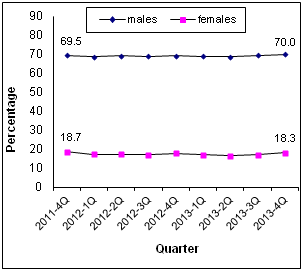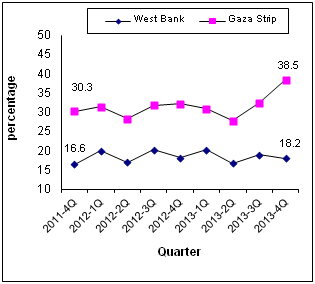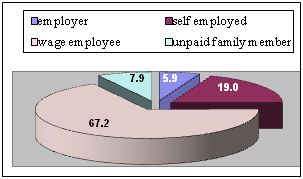Palestinian Central Bureau of Statistics (PCBS)
Press Release on the Results of the Labour Force Survey
(October– December, 2013) Round
Main Results
The labour force participation rate of persons aged 15 years and above was 44.5%
The number of persons participating in the labour force in Palestine was about 1.194 million in the 4th quarter 2013; about 780 thousand in the West Bank and about 414 thousand in Gaza Strip.
The labour force participation rate in the West Bank was 45.7% and 42.4% in Gaza Strip, the gap in the participation rate between males and females still very big it reached 70.0% for males compared with 18.3% for females.
Labour Force Participation Rate by Sex, Q4-2011- Q4-2013

25.2% the unemployment rate among labour force participants
Using ILO standards, the number of unemployed was increased from 275,100 in the 3rd quarter 2013 to 301,200 in the 4th quarter 2013: the number increased in Gaza Strip from 130,200 in 3rd quarter 2013 to 159,600 in 4th quarter 2013, while it decreased in the West Bank from 144,900 to 141,600 in the same period.
The unemployment rate in Gaza Strip increased from 32.5% in the 3rd quarter 2013 to 38.5% in the 4th quarter 2013 while it decreased in the West bank from 19.1% to 18.2% in the same period, and the unemployment rate for males in Palestine was 23.1% compared with 33.5% for females in the 4th quarter 2013.
Unemployment Rate by Region,Q4-2011- Q4-2013

The highest unemployment rate in the 4th quarter 2013 was 43.9% among youth aged 20-24 years. For years of schooling, the unemployment rate among females with 13 years of schooling or more was 46.1%.
The highest unemployment rates in the West Bank governorates was in Hebron with 25.3%. In Gaza Strip, the highest unemployment rate was in Rafah with 48.1%.
According to the relaxed definition of unemployment in Palestine, the unemployment rate increased from 27.1% in the 3rd quarter 2013 to 28.6% in the 4th quarter 2013.
Increased the number of employment in the local market between the 3rd quarter 2013 and 4th quarter 2013
The number of employed in the local market increased from 780 thousand in the 3rd quarter 2013 to 787 thousand in the 4th quarter 2013. The number of employed persons in the West Bank increased by 22 thousand, while the number of employed persons in Gaza Strip decreased by 15 thousand.
The services sector was the biggest employer in the local market with 33.3% in the West Bank and 54.9% in Gaza Strip.
The public sector employed 23.1% of those in employment: 39.5% in Gaza Strip and 16.4% in the West Bank.
The average daily wage for waged employees in the West Bank was 90.2 NIS compared with 64.4 NIS in Gaza Strip.
The average weekly hours worked by waged employees in the West Bank was 42.8 per week in the 4th quarter 2013 compared with 43.3 in the 3rd quarter 2013. The average number of days worked per month increased from 22.3 to 22.4 over the same period. The average number of hours worked per week in Gaza Strip was 38.0 hours per week in the 3rh quarter 2013 compared with 36.6 in the 4th quarter 2013, while the average number of days worked per month increased from 23.8 to 24.2 days over the same period.
Number of employed in Israel and Israeli settlements about 105 thousand in the 4th quarter 2013
The number of employed persons from the West Bank employed in Israel and Israeli settlements increased from 103 thousand in the 3rd quarter 2013 to 105 thousand in the 4th quarter 2013. Of these, 51,700 had a permit, 34,300 worked without a permit and 18,700 employed persons have an Israeli identity card or foreign passport.
Decreased the number of employees in Israeli settlements from 20 thousand in the 3rd quarter to 19 thousand in 4th quarter 2013.
60.9% of employed in Israel and Israeli settlements work in the construction sector.
The average daily wage for persons employed in Israel and Israeli settlements increased from 178.9 NIS in the 3rd quarter 2013 to 182.9 NIS in the 4th quarter 2013.
The average number of hours worked per week increased from 41.6 in the 3rd quarter 2013 to 41.8 in the 4th quarter 2013. The average number of days worked per month remains at the same level 19.7 in the 3rd quarter and 4th quarter 2013.
Employment status in the 4th quarter 2013
67.2% of employed persons are waged employees: 64.6% in the West Bank compared with 73.8% in Gaza Strip.
19.0% of employed persons are self- employed; 18.9% in the West Bank and 19.1% in Gaza Strip.
7.9% of employed persons are unpaid family members: 9.7% in the West Bank and 3.5% in Gaza Strip.
5.9% of employed persons are employers: 6.8% in the West Bank and 3.6% in Gaza Strip.
Percentage Distribution of Employed Persons by Employment Status, Q4-2013

Working benefits for waged employees in the private sector
28.3% of waged employees are hired by contract (10.3% of them with limited period and 18.0% with unlimited period), compared with 49.2% hired without a contract.
20.5% of waged employees contribute to a pension fund; 21.4% have annual paid leave; 34.3% of wage employees women have paid maternity leave.
27.8% of employed persons in Palestine are affiliated to a workers vocational union: 15.1% in the West Bank and 59.7% in Gaza Strip.
36.2% of wage employees in the private sector receive less than minimum wage in Palestine.
In the West Bank about 22.5% of wage employees in the private sector receive less than minimum monthly wage about 46,700 wage employees with average monthly wage 1,035 NIS. the large number of those who receive less the minimum monthly wage are in the north West Bank about 20,300 person with average monthly wage 1,056 NIS, followed by south West Bank governorates about 17,000 with 972 NIS.
In Gaza Strip the percentage of wage employees in the private sector was 68.5% about 59,800 wage employees with average monthly wage 779 NIS. the large number of those who receive less than minimum monthly wage are in north Gaza Strip about 33,900 person with average monthly wage 787 NIS, followed by middle Gaza Strip governorates about 18,400 with 790 NIS.
3.6% of children aged 10-17 years are employed
3.6% of children aged 10-17 years are employed: 4.9% in the West Bank and 1.6% in Gaza Strip.
Data collection of labour force survey was funded by the European Union.
 عربي
عربي